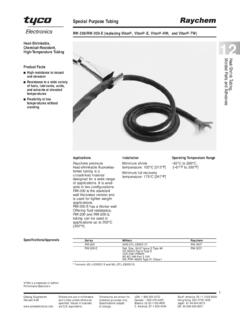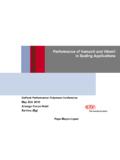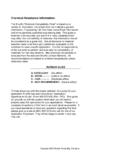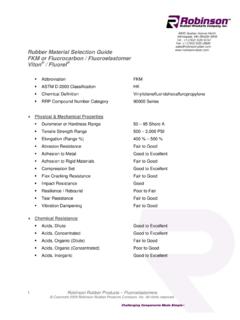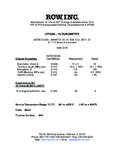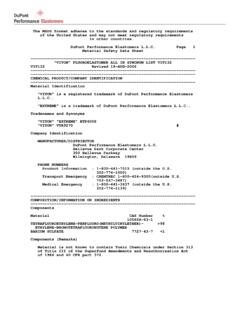Transcription of VITON: An Image-based Virtual Try-on Network - …
1 viton : An Image-based Virtual Try-on NetworkXintong Han, Zuxuan Wu, Zhe Wu, Ruichi Yu, Larry S. DavisUniversity of Maryland, College present an Image-based VIirtual Try-on Network ( viton ) without using 3D information in any form, whichseamlessly transfers a desired clothing item onto the cor-responding region of a person using a coarse-to-fine strat-egy. Conditioned upon a new clothing-agnostic yet descrip-tive person representation, our framework first generates acoarse synthesized image with the target clothing item over-laid on that same person in the same pose. We furtherenhance the initial blurry clothing area with a refinementnetwork. The Network is trained to learn how much detailto utilize from the target clothing item, and where to applyto the person in order to synthesize a photo-realistic imagein which the target item deforms naturally with clear vi-sual patterns. Experiments on our newly collected datasetdemonstrate its promise in the Image-based Virtual try-ontask over state-of-the-art generative IntroductionRecent years have witnessed the increasing demands ofonline shopping for fashion items.
2 Online apparel and ac-cessories sales in US are expected to reach 123 billion in2022 from 72 billion in 2016 [1]. Despite the convenienceonline fashion shopping provides, consumers are concernedabout how a particular fashion item in a product imagewould look on them when buying apparel online. Thus, al-lowing consumers to virtually try on clothes will not onlyenhance their shopping experience, transforming the waypeople shop for clothes, but also save cost for retailers. Mo-tivated by this, various Virtual fitting rooms/mirrors havebeen developed by different companies such as TriMirror,Fits Me,etc. However, the key enabling factor behind themis the use of 3D measurements of body shape, either cap-tured directly by depth cameras [40] or inferred from a 2 Dimage using training data [4,45]. While these 3D model-ing techniques enable realistic clothing simulations on the1 Models and code are available 1: Virtual Try-on results generated by ourmethod.
3 Each row shows a person virtually trying on dif-ferent clothing items. Our model naturally renders the itemsonto a person while retaining her pose and preserving de-tailed characteristics of the target clothing , the high costs of installing hardwares and collecting3D annotated data inhibit their large-scale present an Image-based Virtual Try-on approach, re-lying merely on plain RGB imageswithout leveraging any3D information. Our goal is to synthesize a photo-realisticnew image by overlaying a product image seamlessly ontothe corresponding region of a clothed person (as shown inFigure1). The synthetic image is expected to be perceptu-ally convincing, meeting the following desiderata: (1) bodyparts and pose of the person are the same as in the originalimage; (2) the clothing item in the product image deformsnaturally, conditioned on the pose and body shape of theperson; (3) detailed visual patterns of the desired productare clearly visible, which include not only low-level featureslike color and texture but also complicated graphics like em-broidery, logo,etc.
4 The non-rigid nature of clothes, whichare frequently subject to deformations and occlusions, posesa significant challenge to satisfying these requirements si-multaneously, especially without 3D [ ] 12 Jun 2018 Conditional Generative Adversarial Networks (GANs),which have demonstrated impressive results on image gen-eration [37,26], image -to- image translation [20] and edit-ing tasks [49], seem to be a natural approach for addressingthis problem. In particular, they minimize an adversarialloss so that samples generated from a generator are indistin-guishable from real ones as determined by a discriminator,conditioned on an input signal [37,33,20,32]. However,they can only transform information like object classes andattributes roughly, but are unable to generate graphic de-tails and accommodate geometric changes [50]. This limitstheir ability in tasks like Virtual Try-on , where visual detailsand realistic deformations of the target clothing item are re-quired in generated address these limitations, we propose a Virtual try-onnetwork ( viton ), a coarse-to-fine framework that seam-lessly transfers a target clothing item in a product image tothe corresponding region of a clothed person in a 2D an overview of viton .
5 In particular, we firstintroduce a clothing-agnostic representation consisting of acomprehensive set of features to describe different charac-teristics of a person. Conditioned on this representation, weemploy a multi-task encoder-decoder Network to generate acoarse synthetic clothed person in the same pose wearingthe target clothing item, and a corresponding clothing re-gion mask. The mask is then used as a guidance to warpthe target clothing item to account for deformations. Fur-thermore, we utilize a refinement Network which is trainedto learn how to composite the warped clothing item to thecoarse image so that the desired item is transfered with nat-ural deformations and detailed visual patterns. To validateour approach, we conduct a user study on our newly col-lected dataset and the results demonstrate that viton gen-erates more realistic and appealing Virtual Try-on results out-performing state-of-the-art Related WorkFashion analysis.
6 Extensive studies have been conductedon fashion analysis due to its huge profit potentials. Mostexisting methods focus on clothing parsing [44,28], cloth-ing recognition by attributes [31], matching clothing seenon the street to online products [30,14], fashion recommen-dation [19], visual compatibility learning [43,16], and fash-ion trend prediction [2]. Compared to these lines of work,we focus on Virtual Try-on with only 2D images as task is also more challenging compared to recent workon interactive search that simply modifies attributes ( ,color and textures) of a clothing item [25,48,15], since vir-tual Try-on requires preserving the details of a target cloth-ing image as much as possible, including exactly the samestyle, embroidery, logo, text, synthesis. GANs [12] are one of most popu-lar deep generative models for image synthesis, and havedemonstrated promising results in tasks like image gener-ation [8,36] and image editing [49,34].
7 To incorporatedesired properties in generated samples, researchers alsoutilize different signals, in the form of class labels [33],text [37], attributes [41],etc., as priors to condition the im-age generation process. There are a few recent studies in-vestigating the problem of image -to- image translation us-ing conditional GANs [20], which transform a given inputimage to another one with a different representation. Forexample, producing an RGB image from its correspondingedge map, semantic label map,etc., orvice versa. Recently,Chen and Kolton [6] trained a CNN using a regression lossas an alternative to GANs for this task without adversarialtraining. These methods are able to produce photo-realisticimages, but have limited success when geometric changesoccur [50]. Instead, we propose a refinement Network thatpays attention to clothing regions and deals with clothingdeformations for Virtual the context of image synthesis for fashion applica-tions, Yooet al.
8 [46] generated a clothed person conditionedon a product image andvice versaregardless of the per-son s pose. Lassneret al. [26] described a generative modelof people in clothing, but it is not clear how to control thefashion items in the generated results. A more related workis FashionGAN [51], which replaced a fashion item on aperson with a new one specified by text descriptions. Incontrast, we are interested in the precise replacement of theclothing item in a reference image with a target item, andaddress this problem with a novel coarse-to-fine Try-on . There is a large body of work on virtualtry-on, mostly conducted in computer graphics. Guanet DRAPE [13] to simulate 2D clothing designs on3D bodies in different shapes and poses. Hilsmann and [18] retextured the garment dynamically based on amotion model for real-time visualization in a Virtual mir-ror environment. Sekineet al.
9 [40] introduced a Virtual fit-ting system that adjusts 2D clothing images to users throughinferring their body shapes with depth images. Recently,Pons-Mollet al. [35] utilized a multi-part 3D model ofclothed bodies for clothing capture and retargeting. Yanget al. [45] recovered a 3D mesh of the garment from a sin-gle view 2D image , which is further re-targeted to other hu-man bodies. In contrast to relying on 3D measurements toperform precise clothes simulation, in our work, we focuson synthesizing a perceptually correct photo-realistic imagedirectly from 2D images, which is more computationallyefficient. In computer vision, limited work has exploredthe task of Virtual Try-on . Recently, Jetchev and Bergmann[21] proposed a conditional analogy GAN to swap fashionarticles. However, during testing, they require the prod-uct images of both the target item and the original item onthe person, which makes it infeasible in practical scenar-Person RepresentationClothingMaskReferenceImage GTMaskCoarse ResultPerceptualLossComposition MaskWarpedClothingAlphaCompositionMulti- task ResultI0 GRShapeContextMatchingReferenceImagec0 IL1 LossFigure 2:An overview of viton .
10 viton consists of twostages: (a) an encoder-decoder generator stage ( ),and (b) a refinement stage ( ).ios. Moreover, without injecting any person representationor explicitly considering deformations, it fails to generatephoto-realistic Virtual Try-on VITONThe goal of viton is, given a reference imageIwitha clothed person and a target clothing itemc, to synthesizea new image I, wherecis transferred naturally onto thecorresponding region of the same person whose body partsand pose information are preserved. Key to a high-qualitysynthesis is to learn a proper transformation from productimages to clothes on the body. A straightforward approachis to leverage training data of a person with fixed pose wear-ing different clothes and the corresponding product images,which, however, is usually difficult to a practical Virtual Try-on scenario, only a reference im-age and a desired product image are available at test , we adopt the same setting for training, where areference imageIwith a person wearingcand the productimage ofcare given as inputs (we will usecto refer to theproduct image ofcin the following paper).
![arXiv:0706.3639v1 [cs.AI] 25 Jun 2007](/cache/preview/4/1/3/9/3/1/4/b/thumb-4139314b93ef86b7b4c2d05ebcc88e46.jpg)

![arXiv:1301.3781v3 [cs.CL] 7 Sep 2013](/cache/preview/4/d/5/0/4/3/4/0/thumb-4d504340120163c0bdf3f4678d8d217f.jpg)
![@google.com arXiv:1609.03499v2 [cs.SD] 19 Sep 2016](/cache/preview/c/3/4/9/4/6/9/b/thumb-c349469b499107d21e221f2ac908f8b2.jpg)






